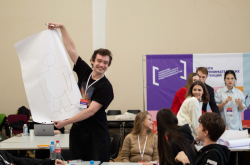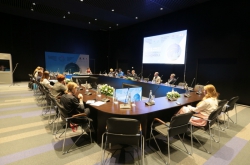You’ve just participated in the Future Technologies acceleration program at ITMO University, but work on your project has been going on for several years. How did it all start?
The project began in 2012. I realized that there is no product on the market that would let drivers who are uneducated on the topic of traffic regulations learn how to tell if an accident was or wasn’t their fault. In 2014, we created the first prototype. It was quite primitive, but proved popular with journalists. They got into an accident, found our project online and did an interview with me about it.
Today there are more than 100 people involved in the project, some as experts, some as testers. For the longest time, we funded it ourselves. Even during a recession, when it got tougher, we kept investing into a project that many might find confusing. It’s hard to judge a project midway through development, and it’s only when you’re done that you can see how important it is. Today we get clients from all over Russia and people are praising our expertise.
How did you come to participate in Future Technologies? How did that affect your product?
One day I just got an email from FT and responded. During the time we spent at ITMO’s business incubator, we reworked our product’s image. For instance, we changed its old, unwieldy name, “Multilevel informational and analytical system for the organization of road traffic safety” to Road Accident Solver.

Our vision for the product has changed a lot, and so has the program itself, as well as its design. The advice we got at FT will help us improve the product’s usability. Our subject is a complicated one, and people who aren’t deeply familiar with it may not understand the more complex cases. Our software includes more than 240 types of accidents, which make up 80 to 85% of all road accidents.
The project has recently become profitable. I’ve never even thought about that aspect, but the people at ITMO explained to me why it’s important. Today, we have a whole team working on the project and everyone gets paid.
How does it work?
Usually when you get into an accident, you’d have to contact the road police or an insurance surveyor. The human factor has a negative influence in these cases. With our system, we’ve eliminated humans from the process. If someone gets into an accident, both sides can agree to submit their data into the system, which compiles a document you can submit to your insurance company. It used to take an hour to fill out a European Accident Statement form, now it takes only five minutes. This helps avoid traffic congestion, too.

What functions are there for experts?
Experts can calculate the kinetic energy involved in the deformation of a car’s body, i.e. the rapid change of speed at the time of impact. They can also determine whether a car’s airbags were deployable without connecting to the car’s control system, which is often damaged, rendering scanners unusable and making it difficult to identify fraud. By law, an insurance company representative can only inspect a car once, which is a source of additional difficulties. Today, by the lowest estimates, insurance companies pay out at least 81 billion rubles a year to fraudsters. In case of pedestrian accidents, we can calculate a car’s speed by the distance to which the victim is thrown. We’ve spent a lot of time on these features, as driver speed is one of the most relevant factors in all investigations. Experts can also check if a car has been involved in other accidents. If, say, the same car has been involved in numerous accidents with different insurance companies, there may be cause for suspicion. We also have a map of accidents, which we can use to identify problem spots on the road.
And some people have found new uses for the system.
Indeed. A few hundred traffic lawyers are using our system to know where to put up their advertisements. Others use it to see if their client can win a case in court. We’ve taken an entire science and condensed it into a single software product.
How does this help law enforcement?
Let’s take the road police, for example. For one, they might have a shortage of patrol cars, a relevant issue in our area. If there are no injuries in an accident, those involved may just choose to use our program and avoid waiting for the police, as most of the time they’re just called to the scene to figure out who’s right and who’s wrong. The system lets them focus on problematic spots where the presence of a patrol car might be necessary.

Has the system performed well with users?
It’s popular in the B2C sector. There are users logging on and using the service every day, which is a success. It’s not every day you get into an accident, so, thankfully, nobody uses it like a social network, but whenever something happens, people know that our system will help them understand what they did wrong.
And what do insurance companies get out of this?
We help them figure out right away if they’re dealing with fraud or a legitimate case. It used to be that these companies would have to pay 15 to 20 thousand rubles for an evaluation, and now they can pay us 1,500 rubles to get an instant result. We provide expertise, European Accident Statements, identify common accident areas and the factors that influenced each case. All reports are produced as PDFs, and all you have to do is print it out. You press three buttons and that’s it. We’re not inventing anything new: our only contribution is a new approach to producing the initial data, which is the hardest part. That’s why there’s no product like this in the world.

What makes it so special?
We use data from crash tests and other evaluations to create our database which is used to calculate the various parameters. We’ve already conducted several road audits that helped change the situation in specific spots and reduced the number of accidents. There are spots that had lethal accidents, and after our involvement there have been no accidents at all.
Have you uncovered any interesting stats?
Many, including government officials, may often not be aware of just how bad the situation can get. In St. Petersburg there’s an average of 300 to 400 accidents per day, of which 8 to 10% involve injuries. On a national level, every 10 minutes ten people are heavily injured and one person dies; out of those people, four will be children. People react strongly to major disasters and tragedies, but few understand just how many we lose every day, and that’s what we need to focus on.

There is interest in your project abroad, too.
Indeed, right now we’re making plans to enter the Chinese market, which we’ve always seen as our initial expansion right from the start, as China very much likes innovations.
How do you plan to develop the project further?
We will soon translate our software into English since clients in the European Union have expressed interest. We’ve also seen our product used in Bulgaria, Ukraine and Belarus, which likely has to do with how the people in those countries are already familiar with the Russian language. There are also many users in Kazakhstan.
Right now we’re working on the final version of the program and working on the engineering psychology aspects of it. We’re also looking into other things: for instance, many drivers tend to miss a majority of the road signs they encounter. We’re creating a device that will help them see each sign. If our work can help save 10,000 people every year, then it’s not in vain.




